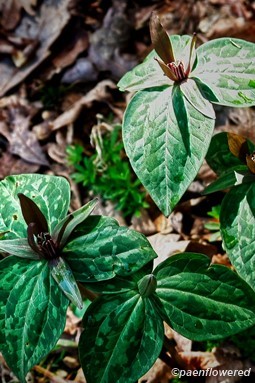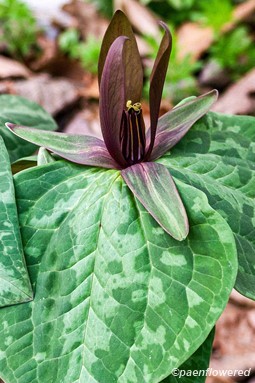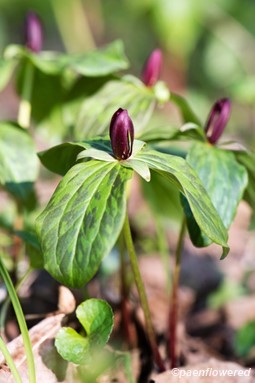Trillium sessile
Trillium sessile toadstool trillium
Except for the characteristic three leaves this unusual member of the bunchflower family does not much resemble the related large-flowered trillium and is one of the more unusual and interesting of the state's wildflowers.
The flower petals are maroon (close to the color of the red or purple trillium) or sometimes greenish in color, making it hard to spot against the forest floor, and the petals are bent upwards giving the flower the appearance of being closed. The petal tips touch or almost touch. Flowers range in size but can be up to one inch high. Beneath the petals are three greenish sepals. In some places I have seen the sepals a maroon color. There are six stamens but these are well hidden. The flower itself also has no stalk, giving rise to the common name of sessile trillium. The flower has the odor of carrion, indicating that flies or beetles are the primary pollinators.
This species is not as common as the large-flowered variety, though it grows in a similar moist woodland habitat. It can grow to a height of 4 to 12 inches, rising from a thick underground rhizome. These can spread the plant to form colonies. It has three round to oval 'leaves' often mottled with purple and white. These 'leaves' are actually enlarged bracts and not true leaves. It is sometimes called the red trillium, but this name is also applied to another species. It is also called the sessile-flowered wakerobin.
The sessile trillium is found from New York State to North Carolina and west to Kansas and Oklahoma. The plant normally blooms from late April to early May. The leaves die back by midsummer. It is considered Endangered in New York State and Threatened in Michigan. Both states are at the northern edge of the species range.
All parts of the plant, especially the seeds are toxic. It is suggested that the cooked leaves could be used as an emergency food. The plant is sometimes used in woodland wildflower gardens, but should never be transplanted from the wild, as the success rate is very low.
Habitat & Range
Infrequent in moist woods.
Mostly found in the west and south-central parts of the state.
Range: Found from New York State to North Carolina and west to Kansas and Oklahoma
| EMP: | UPL |
|---|---|
| NCNE: | FACU |
Phenology
Flowers late April through early May.
Plant Codes
S-rank: No Rank
G-rank: G5 (Secure)












Comments
Have you spotted this plant in your area? We'd love to hear about your experience! Share your comments or questions about the plant below. Comments are moderated before posting.